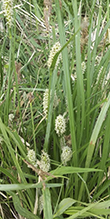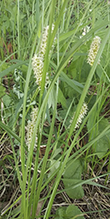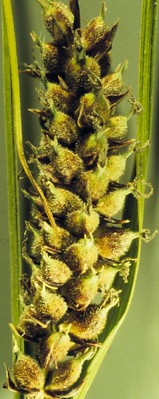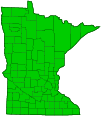woolly sedge
(Carex pellita)
Conservation • Wetland • Description • Habitat • Ecology • Use • Distribution • Taxonomy
Description |
||
Woolly sedge is a common, widespread, easily recognized, true sedge. It is one of the most widespread sedges in North America. It occurs across the United States from Maine and northern Virginia in the east to northern Washington and central California in the west. It also occurs across southern Canada. It is very common in Minnesota, where it has been recorded in each of the state’s 87 counties. It is found in wet meadows, marshes, limy (calcareous) fens, shrubby wetlands (carrs), swampy woodlands, and ditches; on streambanks and lake shores; and in small, moist, disturbed areas. It is also found in dry meadows and on low sand dunes. It is especially common in areas with calcareous soils, but it is also found in areas with neutral soils. It is not found in bogs and other acidic peatlands. Woolly sedge is a perennial sedge that rises on one or a few stems (culms) from a horizontal underground stem (rhizome). The rhizome is well-developed and long creeping, up to 12″ (30 cm) long. It forms large colonies, but the stems are well spaced, not clumped. Non-fertile (vegetative) culms are relatively short, 4¾″ to 12″ (12 to 30 cm) tall. They are actually false stems, composed almost entirely of a series of overlapping leaf sheaths. The lowermost leaves on these stems are reduced to nearly bladeless sheaths. Flowering (fertile) culms are 12″ to 40″ (30 to 100 cm) tall. They are taller than the vegetative culms but do not rise above the leaves. They are acutely triangular, light green, tinged reddish-purple at the base, hairless, and usually rough to the touch on the edges. The base of the stem does not have the remains of last year’s leaves. The leaves are green, slighty yellowish, 1¼″ to 24″ (3 to 60 cm) long, and 1⁄16″ to ¼″ (2 to 6 mm) wide. They are flat or M-shaped in cross section. The middle channel is tight, and the midvein forms a prominent, sharp keel. They are tapered to a long, pointed tip, but the tip is not prolonged. The margins near the tip are rolled under. The blade surface is hairless and is not covered with a whitish bloom (glaucous). The inner face of the sheath at first is membranous and yellowish at the top. It soon becomes bronzish and breaks into horizontal ladder-like fibers as it ages. The tip of the leaf sheath is deeply concave, U-shaped, and is hairless, not fringed. The ligule is thin, membranous, and 1⁄16″ to ½″ (2 to 12 mm) wide. The lowermost leaves are reduced to nearly bladeless sheaths. The lowermost leaf sheaths are reddish-purple and composed of numerous fine fibers. They sometimes break into horizontal ladder-like fibers as they age. Each flowering stem terminates in a 2″ to 12″ (5 to 30 cm) long inflorescence consisting of 1 to 4 male (staminate) spikes above 1 to 3 female (pistillate) spikes. The end (terminal) spike is on a ¾″ to 3½″ (2 to 9 cm) long stalk (peduncle). The remaining (lateral) spikes are stalkless or nearly stalkless. The staminate spikes are erect, cylindrical, linear or narrowly oblong, and ¾″ to 2⅜″ (20 to 60 mm) long. Each spike is composed of numerous, densely overlapping flowers. Each staminate flower is composed of 3 stamens and is subtended by a single scale. The scale is ⅛″ to 3 ⁄16″ (3 to 5 mm) long and light reddish-brown with a lighter center and white margins. The pistillate spikes are ascending, cylindrical, narrowly oblong in outline, ⅜″ to 2″ (10 to 50 mm) long, and 3⁄16″ to 5⁄16″ (5 to 8 mm) wide. Each spike is composed of numerous densely overlapping flowers. Each flower is surrounded by a sac-like structure (perigynium) and is subtended by a single scale. The scale is lance-shaped to egg-shaped. At the tip the sides are straight (acute) or concave (acuminate), and it may end in a short, bristle-like extension (awn). The surface is hairless but may be rough to the touch near the tip. Each perigynium is ascending, swollen, hard, broadly egg-shaped, ⅛″ to 3⁄16″ (2.4 to 5.2 mm) long, and 1⁄16″ to ⅛″ (1.7 to 2.8 mm) wide. It is abruptly contracted at the tip into a short, 1⁄32″ to 1⁄16″ (0.8 to 1.6 mm) long beak. The beak is firm and is divided at the tip into two 1⁄64″ to 1⁄32″ (0.4 to 0.8 mm) long teeth. The perigynium surface is densely covered with short hairs that obscure the veins. The fruit is an achene with 3 stigmas. |
||
Height |
||
12″ to 40″ (30 to 100 cm) |
||
Similar Species |
||
Woolly-fruit sedge (Carex lasiocarpa) leaves and bracts are narrower and tightly rolled, wire-like. |
||
Habitat |
||
Wet meadows, dry meadows, marshes, calcareous fens, carrs, swampy woodlands, ditches, streambanks, lake shores, sand dunes, and disturbed areas. |
||
Ecology |
||
Flowering |
||
May to June |
||
Maturing |
||
Late May to early August |
||
Pests and Diseases |
||
|
||
Use |
||
|
||
Distribution |
||||
|
Sources |
|||
| 6/25/2023 | ||||
Nativity |
||||
Native |
||||
Occurrence |
||||
Very common |
||||
Taxonomy |
|||
| Kingdom | Plantae (Plants) | ||
| Subkingdom | Pteridobiotina | ||
| Phylum | Tracheophyta (Vascular Plants) | ||
| Class | Liliopsida (Monocots) | ||
Order |
Poales (grasses, sedges, cattails, and allies) | ||
Family |
Cyperaceae (sedges) | ||
| Subfamily | Cyperoideae | ||
| Tribe | Cariceae | ||
Genus |
Carex (true sedges) | ||
| Subgenus | Carex | ||
| Section | Paludosae | ||
Subordinate Taxa |
|||
|
|||
Synonyms |
|||
Carex lanuginosa |
|||
Common Names |
|||
broad-leaved woolly sedge woolly sedge |
|||
Glossary
Ascending
Growing upward at an angle or curving upward from the base.
Awn
A stiff, bristle-like appendage at the tip of the glume, lemma, or palea of grass florets.
Beak
In plants: A comparatively short and stout, narrow or prolonged tip on a thickened organ, as on some fruits and seeds. In insects: The protruding, tubular mouthpart of a sucking insect.
Bract
Modified leaf at the base of a flower stalk, flower cluster, or inflorescence.
Culm
The hollow or pithy stem of a grass, sedge, or rush.
Glaucous
Pale green or bluish gray due to a whitish, powdery or waxy film, as on a plum or a grape.
Ligule
In grasses and sedges, an outgrowth on the leaf at the junction of the blade and the sheath, usually membranous, sometimes no more than a fringe of hairs. In flowering plants, the ligule is the flat, strap-shaped, petal-like portion of the corolla of a ray floret.
Peduncle
In angiosperms, the stalk of a single flower or a flower cluster; in club mosses, the stalk of a strobilus or a group of strobili.
Perigynium
In Carex and other closely related sedges, a sac-like or flask-shaped, highly modified bract that surrounds the pistillate flower and later encloses the achene. Plural: perigynia.
Pistillate
Referring to a flower that has a female reproductive organ (pistil) but does not have male reproductive organs (stamens).
Sheath
The lower part of the leaf that surrounds the stem.
Spike
The arrangement of an unbranched, elongated inflorescence with stalkless flowers that mature from the base toward the tip. In Cyperaceae, it also denotes a collection of one or a group of stalkless flowers, each subtended by scales, on a single inflorescence axis.
Staminate
Referring to a flower that has a male reproductive organs (stamens) but does not have a female reproductive organ (pistil).
Visitor Photos |
|||||
Share your photo of this plant. |
|||||
| This button not working for you? Simply email us at info@MinnesotaSeasons.com. Attach one or more photos and, if you like, a caption. |
|||||
Luciearl |
|||||
Found this growing on the shore in my buffer. |
 |
||||
 |
 |
||||
MinnesotaSeasons.com Photos |
|||||
|
|||||

Slideshows |
||
| Carex pellita - woolly sedge Matt Lavin |
||
 |
||
About
Woolly sedge is a native rhizomatous perennial most common in wetlands from low to montane elevations. It is distinguished by conspicuously hairy perigynia each with a distinctly bidentate (split) beak, inflorescence bracts longer than the inflorescence, and leaves that are often 2-5 mm wide and mostly flat. |
||

Visitor Videos |
|||
Share your video of this plant. |
|||
| This button not working for you? Simply email us at info@MinnesotaSeasons.com. Attach a video, a YouTube link, or a cloud storage link. |
|||
Other Videos |
|||

Visitor Sightings |
|||||
Report a sighting of this plant. |
|||||
| This button not working for you? Simply email us at info@MinnesotaSeasons.com. Be sure to include a location. |
|||||
| Luciearl June 2023 |
Location: Lake Shore, Cass County Found this growing on the shore in my buffer. |
||||
MinnesotaSeasons.com Sightings |
|||||

Created: 6/26/2022
Last Updated:

